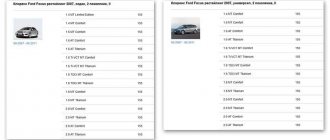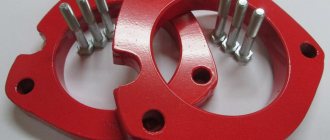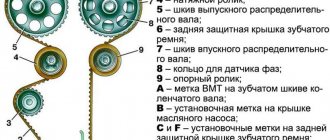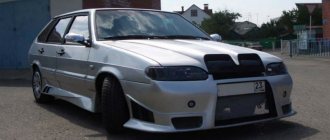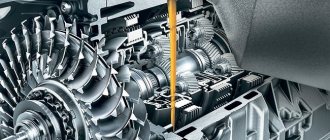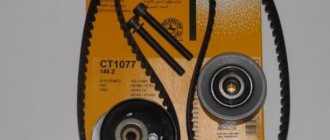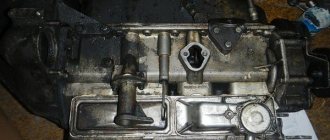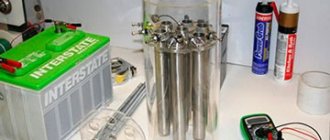Material characteristics
This model is a cylinder shape that is mounted under shock absorbers and suspension springs. Different materials of manufacture, density and dimensions of spacers for increasing ground clearance are determined by the purpose of installation on the front or rear of the car body. As a rule, the choice of one spacer or another does not depend on the make of the car: most parts are universal.
The material used to make parts can be divided into metal (steel or aluminum) and non-metal (polyurethane, plastic). Metal spacers are mounted under the spring, and non-metal spacers are mounted above the spring.
To have a clear idea of the subject, you can watch the installation of a spacer to increase ground clearance with your own hands in the video.
Set of spacers to increase ground clearance - select material
Installing spacers to increase ground clearance can be justified only if it is necessary to return the original ground clearance, which has decreased as a result of shrinkage of the springs. These changes are most suitable for motorists who often have to drive on rural roads.
However, even this fact does not justify the use of spacers with a thickness of more than 30 mm; moreover, it is necessary to take into account what material they are made of.
For example, polyurethane spacers to increase ground clearance, which are installed between the body and the pillar, have one significant drawback. Since their body is made of polyurethane, and the bushings are made of steel, during operation it is the polyurethane that wears out most quickly, as a result of which the steel parts cause damage to the car body.
What is it for?
There are two reasons for raising the vehicle's ground clearance:
- off-road driving;
- sagging of springs over time.
To restore the spring to its original position, special spacers are used. The ideal option would be to replace old springs with new ones at a service station; however, car owners widely practice installing spacers to increase ground clearance with their own hands. If previously, increasing ground clearance was achieved by introducing tennis balls into the springs, now car dealerships sell special spacers of various thicknesses.
What are spacers?
Once upon a time, when car enthusiasts had never even heard of any spacers, they acted in a very original way: they took tennis balls and hammered them between the coils of shock-absorbing springs (those at the back). This simple action made it possible to slightly raise the rear of the car, and therefore reduce the likelihood that it would catch on something on the bottom, falling into another pothole on the wonderful domestic road. But everything is changing, and the days of tennis balls are gone. Now any car owner can simply visit the nearest car market and buy a set of rubber gaskets to increase the ground clearance of the car. These are the spacers. It should also be noted that spacers are different. They differ both in the material of manufacture (it is not always rubber) and in size (after all, some people want to raise the car higher, others lower). In addition, the material of the spacers may be different on different shock absorbers. As a rule, metal spacers made of either steel or aluminum are placed under the front shock absorbers. And spacers for the rear springs can be rubber, plastic, polyurethane, etc.
Pros and cons of the clearance operation
Is there really a need to tune the suspension, and will such a change damage the car? Before installing aluminum spacers under the springs, let’s pay attention to the positive aspects of the changes:
- protection of the rear suspension, underbody and crankcase from breakdowns;
- protection of the rear wheels from impacts on the fender liner;
- increasing the vehicle's off-road capability.
The disadvantages of installing a spacer under the springs with your own hands include:
- failure of the lower shock absorber mounting;
- additional load on the bottom bracket;
- car instability on an icy surface;
- impairment of vehicle controllability due to a shift in the center of gravity;
- rapid wear of steering parts;
- imbalance of wheel alignment.
After tuning, the car owner needs to pay more attention to the suspension in general and shock absorbers in particular.
What to choose?
What are spacers made of to increase ground clearance? The choice of material depends on the design of your machine. In the front compartment of the car, spacers made of metals are mounted: steel or aluminum alloys. It is recommended to place rubber or plastic products under the rear springs.
Which spacers are best for increasing ground clearance? Firstly, you cannot install any spacers over 30 mm thick. Secondly, polyurethane products can cause damage to the body by steel bushings due to rapid wear.
Aluminum products are the most reliable, although they cause corrosion at points of contact with the body. In practice, plastic spacers have shown themselves to work well to increase ground clearance, without revealing any serious shortcomings. Rubber material is the cheapest, but is prone to tearing, deformation and rapid wear.
About the body and suspension lift
What are spacers?
Once upon a time, when car enthusiasts had never even heard of any spacers, they acted in a very original way: they took tennis balls and hammered them between the coils of shock-absorbing springs (those at the back). This simple action made it possible to slightly raise the rear of the car, and therefore reduce the likelihood that it would catch on something on the bottom, falling into another pothole on the wonderful domestic road. But everything is changing, and the days of tennis balls are gone. Now any car owner can simply visit the nearest car market and buy a set of rubber gaskets to increase the ground clearance of the car. These are the spacers. It should also be noted that spacers are different. They differ both in the material of manufacture (it is not always rubber) and in size (after all, some people want to raise the car higher, others lower). In addition, the material of the spacers may be different on different shock absorbers. As a rule, metal spacers made of either steel or aluminum are placed under the front shock absorbers. And spacers for the rear springs can be rubber, plastic, polyurethane, etc.
There are both pros and cons to using spacers to increase ground clearance.
The advantages were listed above - increased cross-country ability and underbody protection.
But there are a number of disadvantages that should also be discussed.
- First of all, spacers (especially rear ones), no matter how high quality they are, wear out quickly.
- We should not forget that the center of gravity of a raised car shifts, which means that it becomes more difficult to control this car, and it will not respond to steering movements as sensitively as before installing the spacers.
- In addition, installing spacers is a serious violation of the integrity of the car’s suspension. After their installation, the wheel alignment of the car slightly changes, the overall width of the wheelbase of the car changes, and the angle of inclination of the turned wheels changes. As a result of these seemingly minor design changes, the steering mechanism components begin to wear out much faster.
- And finally, after installing spacers, shock absorbers begin to work worse, which is not surprising: after all, their position and angle of inclination have also changed.
Installation Rules
To properly make spacers for springs with your own hands, you need to take into account some nuances:
- Setting the ground clearance above 30 mm leads to wheel alignment problems.
- It is not recommended to install metal products that have not been pre-treated against corrosion.
- It is recommended to raise the front of the body by no more than 20 mm.
- The rear compartment of the body is raised by no more than 30 mm.
- If the shock absorber is not located next to the spring, spacers should be mounted under the springs and shock absorbers to balance the structure.
Installing spacers on rear pillars
To raise the rear part of the body above the road surface, thicker rubber spacers are installed under the springs instead of the factory spacers. Unlike the front ones, they do not deform the body, do not rust and do not have a negative impact on the performance of the car. But, as they say, to each his own, if you choose a different kit, you will still have to install it according to the general principle.
- Depending on the type of car, you will have to do something like the following. Remove the sills under the trunk lid and near the rear doors. Move the rear seats as far forward as possible. Remove the trim and lining from the trunk. Do the same with the trims and trims of the side panels near the rear seats. In fact, you should be able to see the metal skeleton of your car.
- After the preparatory work, we jack up the rear wheel and proceed as when upgrading the front part. We remove the wheel and begin to struggle with the support. Having unscrewed the upper and lower nuts, remove the support and examine the bolts. Most likely they also need to be replaced with longer ones. Sometimes there is a danger that the “non-original” bolts will not hold well, since there is no special sealing skirt. Resourceful car owners simply weld new bolts onto the strut.
- We install the spacer and assemble everything in reverse order. Let's polish up the interior and we can call it a day. Everything may not be so difficult if you have a simpler car model than a Japanese Toyota. And there are also the same problematic designs, and you will have to work hard. In any case, do not forget about the instruction manual for each machine; it will help you calculate the most rational path to the treasured nuts.
Front installation procedure
How to install spacers to increase ground clearance in the front part of the body? To do this, follow the recommendations:
- We lift the car with a jack, remove the tire, disconnect the braking system and the stabilizer link.
- We install other bolts of the required size on the rack (the old ones do not fit in length).
- We fix the spacer to the bolt and assemble the entire structure to its original state.
For greater clarity, you can see the diagram for installing a spacer to increase ground clearance with your own hands in the drawings.
Rear installation procedure:
- We disconnect the thresholds under the loading compartment lid and the rear door area.
- Move back the rear seats.
- We remove the panels and leave one body.
- We remove the wheel.
- We install the bolts according to the example of the front part of the body.
- We assemble the structure in reverse order.
If the word “jack” causes you vague anxiety, and the idea of the location of the bolts seems unclear, watch the procedure for installing a spacer under the springs in the video.
How to increase clearance yourself
You can increase the clearance yourself. Most often, special devices are used for this - spacers.
Selection of materials
Spacers to increase vehicle clearance are made from the following materials:
Each material has its own advantages and disadvantages.
Rubber spacers
- resistant to external influences in the form of acid, salt, alkali;
- do not affect vehicle handling and comfort in the cabin;
- do not have a corrosive effect on the car body;
- They are inexpensive on the car market.
- rapid wear;
- subject to deformation and damage.
Rubber spacers are secured under the springs.
Polyurethane spacers
In addition to the advantages of rubber, they have in addition:
- higher strength;
- can take a significant load without breaking;
- capable of smoothing out impacts from uneven road surfaces.
The disadvantages include:
- high pressure on the bushings;
- possibility of deformation of the car body.
These spacers are also suitable for installation under springs. They cost more than rubber ones, but cheaper than metal ones.
Aluminum spacers
All of the above advantages of other materials are more pronounced in aluminum spacers. In addition, they do not wear out for a long time.
The only significant drawback is the possibility of corrosive effects upon contact with the car body. They are usually attached at the junction of the shock absorbers with the car.
ABS plastic
Currently, it is the most acceptable material for spacers in the automotive market. It has all the advantages of previous models, but without their disadvantages.
Plastic spacers are placed under the springs.
Installing spacers on the front of the car
Installation of spacers at the front of the machine is carried out according to the following instructions:
- The car is jacked up and the wheel is removed.
- Disconnect the brake hoses and unscrew a couple of nuts from the front strut, having previously tightened the springs with a tie.
- The stand is removed by unscrewing the nuts from the upper support.
- Old bolts are replaced with new ones of longer length.
- The spacer is bolted and assembled in the reverse order. If there is interference from the transverse pillar, it is supported with a second jack.
- All the same actions are repeated with the second wheel.
Installing rear spacers
Installation of spacers on the rear of the car is carried out according to the following instructions:
- The thresholds from the rear doors of the car and under the luggage compartment lid are removed.
- The rear seats move forward as much as possible. Remove the trim from the trunk and sides, completely exposing the body.
- Raise the car from behind with a jack and remove the wheel.
- Tighten the nuts from above and below, remove the support.
- Old bolts are replaced with new ones of longer length.
- Attach the spacer to the bolts and reassemble in the reverse order.
Bottom line
When creating a car, design engineers calculate every millimeter, establishing a certain balance between the parts and assemblies of the vehicle. Any change made to the design of a car in order to improve technical characteristics introduces a certain imbalance into the overall structure.
It is not always possible to increase the cross-country ability of a car designed to drive on asphalt. No matter how hard you try to change or improve the condition of the suspension using various manipulations, you will not be able to improve the design to the condition of an SUV. Either buy an SUV, or resign yourself to driving on city highways.


